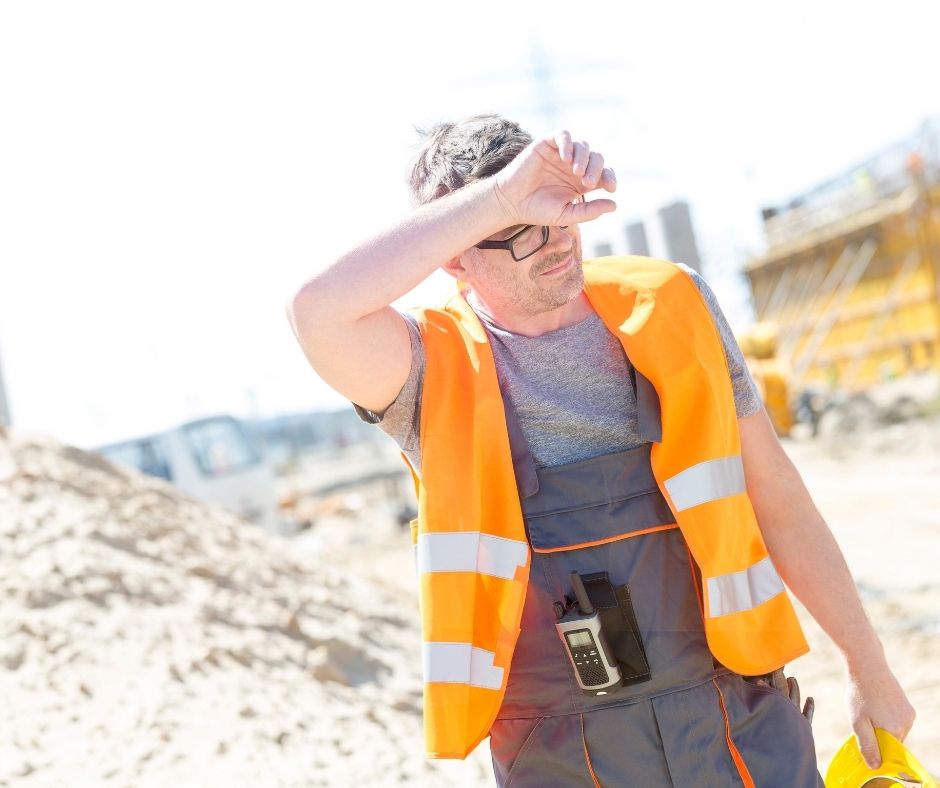Heat stress, whether it be due to working during the summer months or in an environment that is hot year-round, can put employees at risk of heat exhaustion and, more seriously, heatstroke. HSE guidance leaflet INDG451 states that heat stress occurs when the body’s means of controlling its internal temperature starts to fail. Air temperature, work rate, humidity and work clothing are all factors that can cause heat stress. Whilst in some cases the risk may be fairly obvious (think stifling hot bakery on a humid day!), individual factors such as the aforementioned work rate and clothing can make the risk of heat stress easy to miss at first glance.
What is heat exhaustion?

The body works best when its temperature is close to 37°C – this temperature is maintained by an area of the brain called the hypothalamus. If we become too hot, the body produces sweat which evaporates and cools the skin. Blood vessels near to the skin dilate and the cooled blood is pumped around the body. Heat exhaustion is how the body responds to loss of water and salts through excessive sweating and generally occurs when the core body temperature exceeds 38°C. If not treated, heat exhaustion can lead to heatstroke, which is a separate and more serious condition.
Wearing PPE and performing heavy works in hot and humid conditions such as construction type works outside during a hot summers day is an obvious way of developing heat exhaustion, but also consider that it is possible to experience heat exhaustion in cold environments such as chilled distribution warehouses if factors such as thermal clothing and work rate are not taken into consideration.
The body may still work up a sweat due to the work that it is doing however the thermal properties of any protective clothing may trap the excess heat and sweat preventing the body from cooling down. The effects of which may be masked due to the cold nature of the environment.
How can you identify heat exhaustion?
The effects of extreme heat can affect individuals in different ways, and some people are more susceptible than others. Knowing the common signs and symptoms can be the key to identifying if someone is suffering. These include:
- An inability to concentrate
- Severe thirst
- Muscle cramps
- Pale, sweaty skin
- Nausea and vomiting
How do you treat heat exhaustion?

Whilst preventing someone from reaching the stage of heat exhaustion is ideal, and can be achieved through proper controls, there are still occasions where it may happen. Knowing how to treat someone who is suffering from the effects of heat is important. The best course of action is to:
- Remove them to a cool place
- Remove excessive clothing and lie them down
- Give them plenty of water to help re-hydrate them, Dioralyte or isotonic drinks are also useful as they will help replace lost body salts
- Call 999/112 for emergency assistance if they do not seem to respond to treatment, as the condition may be more severe so they will need treating for heatstroke.
What is heatstroke?
Heatstroke is caused due to failure of the hypothalamus. The sweating mechanism fails so the body is unable to cool down and core body temperatures can reach dangerously high levels, and can reach over 40°C in 10-15 minutes. The condition can be caused by a high fever or prolonged exposure to heat and often follows heat exhaustion.
How can you identify heatstroke?

The main clues to recognising heatstroke are signs that the brain is overheating:
- Dizziness, fainting, severe confusion and restlessness
- Throbbing headache
- Lowered levels of response
- Nausea and vomiting
- Flushed, hot, dry skin with no sweating
- There may also be a possibility of seizures
How do you treat heatstroke?
Quick treatment is key if you suspect someone has heatstroke:
- Immediately move them to a cool shaded area and call 999/112 for emergency help
- Cool them rapidly using whatever means you can, remove outer clothing and wrap them in a cold wet sheet if possible. Keep the sheet wet until their temperature returns to normal, then replace with a dry sheet
- Continually sponging with tepid water and fanning them to help it evaporate
- Place them in a cool shower if they are conscious enough to do so
- Spray them with cool water from a hose, as a mist works best
To learn more about workplace hazards, risks and accident prevention, check out our RoSPA Accredited Health and Safety Site Induction online training course. Alternatively, if you’re in need of first aid certification, book onto one of our full First Aid Training courses!
Written by Neil Ward, Training Consultant at WA Management.

